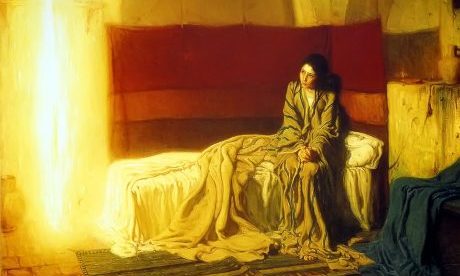Henry Ossawa Tanner (1859-1937), the first African-American painter ever to gain international acclaim, treats the classic Annunciation motif in a rather unconventional manner: he reckons the simplicity of the scene, rather than its theatrical recreation.
In the intimacy of a chamber, Mary is portrayed as a dark haired Jewish peasant girl, seated at the edge of her couch in a striped crumpled attire.
The orderly arrangement of the room, in contrast to her bed, suggests that Mary has suddenly been awakened in the middle of the night.
The blinding form of the angel is the only source of light in the room.
As this infused flood of golden light falls onto Mary’s face, it allures us to where fear begins to give way to contemplation and contemplation to acceptance. It arrests our attention and ignites our imagination.
The Virgin wears no halo or celestial attribute. Her hands humbly clasped, her head tilted upwards and her eyes focused.
She is clearly receptive and open to God’s will. Domesticity is now no stranger to epiphany. Peeking below her cascading drapery one finds Mary’s bare foot.
This is an unusual Marian symbol, rarely found in classical depictions of the Annunciation.
But for Tanner, it signified the humanity and simplicity of the Blessed Virgin.
Tanner employs a variety of other visual mediums in the painting to emphasize upon the transcendence of the event we are witnessing.
Across Mary’s room are strewn three undecorated clay vessels. They acknowledge the presence and providence of the Trinity. T
he vessel also serves as a reminder of the Virgin herself who partook in the mystery of the Trinity as a “vessel of honor” to bring the Messiah into the world.
The next feature is equally intriguing. Having no physical appearance or angelic wings, Gabriel is rather depicted as a pillar of light.
However, at a closer glance, one observes that this vertical beam intersects with the horizontal shelf to form a cross.
It thus foreshadows the Crucifixion as it proclaims the Incarnation at the same time.
The colors of the composition further embellish the liturgical and artistic beauty of the painting: red symbolizes love, white signifies purity, blue stands for wisdom, and gold is reminiscent for divinity. Continue reading
Source and Image:
- Aleteia article by Joynel Fernandes, Assistant Director of the Archdiocesan Heritage Museum, Mumbai, India.
News category: Features.




